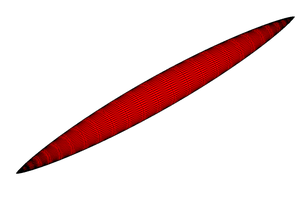Eckart conditions: Difference between revisions
en>Mets501 m clean up, typos fixed: , → , using AWB |
en>Suslindisambiguator |
||
| Line 1: | Line 1: | ||
[[Image:Sears-Haack.png|right|thumb|Sears–Haack body]] | |||
The '''Sears–Haack body''' is the aerodynamic body shape with the lowest theoretical [[wave drag]]. Aircraft designed to operate at high subsonic or supersonic speeds have their cross-sectional areas designed to match as closely as possible the proportions of the Sears–Haack body.<ref>[http://www.princeton.edu/~achaney/tmve/wiki100k/docs/Area_rule.html Area Rule]</ref> | |||
By [[Area rule|Whitcomb area rule]], the derivative of the cross-sectional area gives the wave drag. Thus, the Sears–Haack body is pointed at each end and grows to a maximum and then decreases toward the second point. | |||
Under the area rule, shapes with the same cross-sectional area at each point along their length as this shape have the minimal amount of wave drag, and the overall shape of many aircraft designed with [[transonic]] flight considerations have cross-sectional areas that approach this form (despite appearances). | |||
[[Image:Area rule unifilar drawing.svg|thumb|Cross-sectional area distribution along the body determines wave drag, largely independent of the actual shape. Although not congruent, the blue and green shapes are roughly equal in area, being equidistant from the longitudinal centre.]] | |||
The derivation and shape were published independently by two separate researchers: [[Wolfgang Haack]] in 1941 and later by [[William R. Sears|William Sears]] in 1947.<ref> | |||
{{cite conference | |||
| url =http://aero-comlab.stanford.edu/Papers/palaniappan.aiaa.04-5383.pdf | |||
| title =Bodies having Minimum Pressure Drag in Supersonic Flow – Investigating Nonlinear Effects | |||
| first =Karthik | |||
| last =Palaniappan | |||
| year =2004 | |||
| conference =22nd Applied Aerodynamics Conference and Exhibit | |||
| others =Antony Jameson | |||
| accessdate =2010-09-16 | |||
}}</ref> | |||
==Useful Formulas== | |||
The cross sectional area of a Sears–Haack Body is: | |||
:<math> A(x) = \frac {16V}{3L\pi}[4x(1-x)]^{3/2} = \pi R_{max}^2[4x(1-x)]^{3/2} </math> | |||
The volume of a Sears–Haack Body is: | |||
:<math> V = \frac {3\pi^2}{16}R_{max}^2 L </math> | |||
The radius of a Sears–Haack Body is: | |||
:<math> r(x) = R_{max}[4x(1-x)]^{3/4} </math> | |||
The derivative (slope) is: | |||
:<math> r'(x) = 3R_{max}[4x(1-x)]^{-1/4} (1-2x) </math> | |||
The second derivative is: | |||
:<math> r''(x) = -3R_{max}\{[4x(1-x)]^{-5/4} (1-2x)^2 + 2[4x(1-x)]^{-1/4}\}</math> | |||
where: | |||
''x'' is the ratio of the distance from the nose to the whole body length. This is always between 0 and 1. | |||
''r'' is the radius | |||
<math> R_{max} </math> is the radius at its maximum (occurs at center of the shape) | |||
''V'' is the volume | |||
''L'' is the length | |||
<math> \rho </math> is the density of the fluid | |||
''U'' is the velocity | |||
From [[Slender-body theory]]: | |||
:<math> D_\text{wave} = - \frac {1}{4 \pi} \rho U^2 \int_0^\ell \int_0^\ell S''(x_1) S''(x_2) \ln |x_1-x_2| \mathrm{d}x_1 \mathrm{d}x_2 </math> | |||
alternatively: | |||
:<math> D_\text{wave} = - \frac {1}{2 \pi} \rho U^2 \int_0^\ell S''(x) \mathrm{d}x \int_0^x S''(x_1) \ln (x-x_1) \mathrm{d}x_1 </math> | |||
These formulas may be combined to get the following: | |||
:<math> D_\text{wave} = \frac{64 V^2}{\pi L^4} \rho U^2 </math> | |||
:<math> CD_\text{wave} = \frac {24V} {L^3} </math> | |||
==See also== | |||
* [[Area rule]] | |||
* [[Aerodynamics]] | |||
* [[Anti-shock body]] | |||
* [[Nose cone design#Haack series|Haack series nose cone]] | |||
* [[Transonic]] | |||
==References== | |||
<references/> | |||
==External links== | |||
* [http://www.lima-wiederladetechnik.de/Englisch/Haack_minimum_drag_bullet.htm Haack Minimum Drag Rifle Bullet] Site down – http://web.archive.org/web/*/http://www.lima-wiederladetechnik.de/Englisch/Haack_minimum_drag_bullet.htm | |||
* [http://www.lima-wiederladetechnik.de/Ballistik/Lilienthal-139-1-Haack.pdf Geschoßformen kleinsten Wellenwiderstandes by W. Haack, Bericht 139 der Lilienthal-Gesellschaft (1941)] | |||
{{DEFAULTSORT:Sears-Haack body}} | |||
[[Category:Aerodynamics]] | |||
Revision as of 12:22, 14 September 2013

The Sears–Haack body is the aerodynamic body shape with the lowest theoretical wave drag. Aircraft designed to operate at high subsonic or supersonic speeds have their cross-sectional areas designed to match as closely as possible the proportions of the Sears–Haack body.[1]
By Whitcomb area rule, the derivative of the cross-sectional area gives the wave drag. Thus, the Sears–Haack body is pointed at each end and grows to a maximum and then decreases toward the second point.
Under the area rule, shapes with the same cross-sectional area at each point along their length as this shape have the minimal amount of wave drag, and the overall shape of many aircraft designed with transonic flight considerations have cross-sectional areas that approach this form (despite appearances).

The derivation and shape were published independently by two separate researchers: Wolfgang Haack in 1941 and later by William Sears in 1947.[2]
Useful Formulas
The cross sectional area of a Sears–Haack Body is:
The volume of a Sears–Haack Body is:
The radius of a Sears–Haack Body is:
The derivative (slope) is:
The second derivative is:
where:
x is the ratio of the distance from the nose to the whole body length. This is always between 0 and 1.
r is the radius
is the radius at its maximum (occurs at center of the shape)
V is the volume
L is the length
U is the velocity
From Slender-body theory:
alternatively:
These formulas may be combined to get the following:
See also
References
- ↑ Area Rule
- ↑
55 years old Systems Administrator Antony from Clarence Creek, really loves learning, PC Software and aerobics. Likes to travel and was inspired after making a journey to Historic Ensemble of the Potala Palace.
You can view that web-site... ccleaner free download
![A(x)={\frac {16V}{3L\pi }}[4x(1-x)]^{{3/2}}=\pi R_{{max}}^{2}[4x(1-x)]^{{3/2}}](https://wikimedia.org/api/rest_v1/media/math/render/svg/41055090ef73f5bd41ff1e1c51703ba08d4c591d)

![r(x)=R_{{max}}[4x(1-x)]^{{3/4}}](https://wikimedia.org/api/rest_v1/media/math/render/svg/712bc97e0d7b327f030ee8c4a57bac7b6dca6b23)
![r'(x)=3R_{{max}}[4x(1-x)]^{{-1/4}}(1-2x)](https://wikimedia.org/api/rest_v1/media/math/render/svg/b0657cb6c509b4f0176e8bfb681254e170ee32b0)
![r''(x)=-3R_{{max}}\{[4x(1-x)]^{{-5/4}}(1-2x)^{2}+2[4x(1-x)]^{{-1/4}}\}](https://wikimedia.org/api/rest_v1/media/math/render/svg/c8c56a62a45758e88da0093cad9455b7d7b82b5c)





